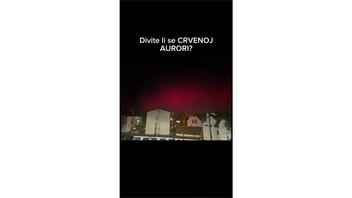
Are the red northern lights seen all over Croatia on November 5, 2023, a sign of harmful cosmic radiation exposure? No, that's not true: Northern lights -- also known as aurora borealis -- result from the collision of charged solar particles with the Earth's atmosphere. They are seen as a display of dynamic patterns of lights that appear as different shapes covering the entire sky. They are not a source of radiation and do not produce any pollution or emissions that could be harmful.
The claim appeared in a TikTok video (archived here) on November 6, 2023. It began (translated from Croatian to English by Lead Stories staff):
Are you admiring the RED AURORA? It was noticed yesterday in Croatia. It's like admiring a guillotine blade. The red aurora borealis is a clear sign of the weakening of the Earth's magnetic field, which means we are exposed to even fiercer cosmic radiation.
This is what the post looked like on TikTok at the time of writing:
(Source: TikTok screenshot taken on Tue Nov 7 09:12:56 2023 UTC)
The TikTok video references a YouTube video posted by Creative Society, an online activist group known for promoting misinformation and conspiracy theories, such as denying climate change.
On November 5, 2023, the bright red skies above Croatia showed a natural phenomenon -- the aurora borealis. In Croatia it can be observed every 20 to 25 years when solar particles are deflected towards the poles of the Earth by our planet's magnetic field and interact with our atmosphere, depositing energy and causing the atmosphere to fluoresce. The lights are usually seen near the poles, and their shape and colors vary based on the gases present in the atmosphere. For example, oxygen emits green and red light, while nitrogen shines blue and purple. Auroras occur on other planets too, since all that is required is an atmosphere and a magnetic field. The aurora borealis phenomenon does not mean that the Earth's magnetic field is weak; if it were or if there were no magnetic field at all, then there would be an extremely dim, diffuse aurora visible at almost all latitudes.
According to the U.S. Centers for Disease Control and Prevention, we are constantly exposed to low levels of radiation. One natural source of radiation comes from space. Cosmic radiation exposes the body to a kind of radiation similar to the exposure we get from medical X-rays. In the U.S., the average annual dose due to cosmic radiation is 0.33 millisievert (33 millirems) per year. This low radiation dose is considered unlikely to affect human health.
The Earth's atmosphere and magnetosphere keep us safe from the harmful effects of cosmic radiation. Furthermore, those who observe the phenomenon on Earth do not come into direct contact with it. In addition, the aurora borealis does not produce any pollution or emissions that could be harmful to humans and there is no harmful radiation caused by the northern lights. The light we see from the aurora borealis is a form of electromagnetic radiation. X-ray radiation has also been detected from the collisions, but they are absorbed by the lower parts of the Earth's atmosphere and do not reach the surface, therefore they are not harmful to humans.











